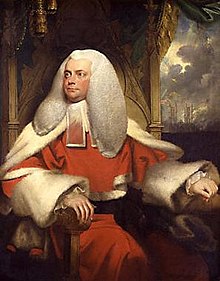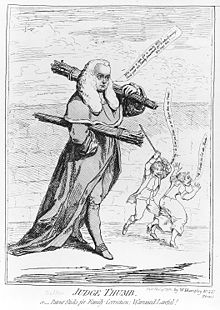Sir Francis Buller, 1st Baronet
Sir Francis Buller | |
|---|---|
 | |
| King's Bench | |
| In office 6 May 1778 – 19 June 1794 | |
| Succeeded by | Sir Francis Buller-Yarde-Buller, 2nd Baronet |
| Personal details | |
| Born | 17 March 1746 King's School Ottery St. Mary , London.Christ's Hospital |
| Occupation | Judge |


Sir Francis Buller, 1st Baronet (17 March 1746 – 5 June 1800) was an English judge.
Origins
Buller was born at
Career
Legal career
After an education at
His conduct on the bench, however, was often the subject of severe criticism, and he was accused of being hasty and prejudiced. He has been the subject of controversy over time due to an alleged statement he made that "a husband could thrash his wife with impunity provided that he used a stick no bigger than his thumb".
He was one of the three judges in the 1783 appeal hearing of the
Buller was always the second judge in his court, although when
He was a guardian of Lady Anne Brydges (died 1836) daughter and sole heiress of
Moorland improver

In 1790 or shortly before, Buller bought the Ancient Tenement of Prince Hall on Dartmoor, Devon, from Christopher Gullet who had acquired it some ten years earlier and had already built new farm buildings on the old site. Buller greatly extended the buildings, converting the property into one of "Georgian opulence".[5] He was friendly towards his tenants and other workers on the moor, whom he invited to weekly religious services at Prince Hall.[5]
He also enclosed some 2,000 acres around Prince Hall,[6] and set about improving the land. There was a strong belief amongst forward thinkers of the time that Dartmoor's poor moorland soil could be "improved" for agriculture. Robert Fraser in his 1794 book General View of the Agriculture of the County of Devon (one of the General View of Agriculture county surveys series) promoted Buller's programme of fertilising the soil, improving the breeds of sheep and cattle and large scale planting of trees, as an example of best practice – even though he noted that almost all of the 40,000 larch and other conifers that Buller had planted had already died.[7] The avenue of trees leading to the property has, however, survived to the present day.[5] While Buller was attempting to "improve" Dartmoor at Prince Hall, Thomas Tyrwhitt was doing the same at nearby Tor Royal.[8]
Buller acquired other estates on Dartmoor, including Skerraton in the parish of Dean Prior.[9] He also built an inn, named the Saracen's Head after the Buller family's crest, at Two Bridges, on a site now occupied by the Two Bridges Hotel.[10]
Marriage and children

In 1763, at the age of 17, he married a wealthy heiress, namely Susanna Yarde (1740–1810), only daughter and sole heiress of Francis Yarde (1704–1750) of
- Edward Buller, first-born son and .
- Sir Francis Buller-Yarde-Buller, 2nd Baronet (1767–1833), second and eldest surviving son and heir,[14] who in compliance with the will of his maternal great-uncle John Yarde (1702–1773) assumed the surname Yarde in lieu of his patronymic, but later by royal sign manual added the additional surname Buller.[15]He was the father of:
- John Yarde-Buller, 1st Baron Churston (1799–1871), eldest surviving son, who was raised to the peerage in 1858;
- Sir Edward Manningham-Buller, 1st Baronet (1800–1882), second surviving son, created a baronet in 1866, whose descendant was created Viscount Dilhorne in 1964.[16]
Death, burial & monument

In the late 1790s Buller was in poor health, suffering from frequent attacks of
A mural monument to him survives in the Yarde-Buller Chapel, north transept of St Mary's Church, Brixham, the parish church of Lupton House, inscribed in Latin as follows:- M(emoriae) S(acrum) Francisci Buller Baronetti per plus quam septemdecem annos Banci Regis deinde per sex annos Banci Communis Justiciarii viri memorabilis qui in causis discendis acumine et diligentia in indagando jure industria et in interpretando solertia nimini cessit. Natus in parochia Crediensi 28 die Martii 1746 obiit Londini 4 die Junii 1800 et sepultus est in caemeterio Divi Andrea prope Hospitium Grayense juxta reliquias Edwardi Buller filii primo-geniti
which may be translated as:
- "Sacred to the memory of Francis Buller, Baronet, for more than seventeen years a Justice of the King's Bench, thereafter for six years of the Common Pleas, a memorable man who in cases to be decided ceded to no man in sharpness and diligence in researching the law and in industry and interpretation with skilfulness. He was born in the parish of Crediton on the 28th day of March 1746 he died in London on the 4th day of June 1800 and was buried in the cemetery of St Andrew's near Gray's Inn next to the remains of Edward Buller his first-born son".
Sculpted below in low relief is a sword of justice crossed by a beam of a set of scales of justice. At top is shown a shield of the Buller arms with inescutcheon of pretence of Yarde (of 4 quarters) for his heiress wife Susanna Yarde.
Notes
- ^ Burke's Landed Gentry, 1937, p. 279, Buller of Downes
- ^ a b c d e Courtney 1886.
- ^ Gale, Giles Jacob. The Laws of Appeal and Murder, (1719). p. 38.
- ^ "No. 13152". The London Gazette. 28 November 1789. p. 741.
- ^ a b c d Hemery, p.462
- ^ Milton, p.32.
- ^ Milton, p.35, citing Fraser pp. 57–59
- ^ Milton, pp. 33–34
- ^ Hemery, p.603
- ^ Crossing, William (1967). Le Messurier, Brian (ed.). Crossing's Hundred Years on Dartmoor. Newton Abbot: David & Charles. pp. 31, 74.
- ^ History of Parliament Online YardeE, Edward (1669–1735), of Churston Court, Devon
- ^ Vivian (1895), p. 831, pedigree of Yard
- ^ Vivian (1887), p. 60, pedigree of Buller
- ^ Vivian (1887), p. 58, pedigree of Buller
- ^ Vivian (1887), p. 60
- ^ Montague-Smith, P.W. (ed.), Debrett's Peerage, Baronetage, Knightage and Companionage, Kelly's Directories Ltd, Kingston-upon-Thames, 1968, p. 360
References
 This article incorporates text from a publication now in the public domain: Courtney, William Prideaux (1886). "Buller, Francis". In Stephen, Leslie (ed.). Dictionary of National Biography. Vol. 7. London: Smith, Elder & Co.
This article incorporates text from a publication now in the public domain: Courtney, William Prideaux (1886). "Buller, Francis". In Stephen, Leslie (ed.). Dictionary of National Biography. Vol. 7. London: Smith, Elder & Co.- Hemery, Eric (1983). High Dartmoor. London: Robert Hale. ISBN 978-0-7091-8859-9.
- Milton, Patricia (2006). The Discovery of Dartmoor, a Wild and Wondrous Region. Chichester: Phillimore. ISBN 978-1-86077-401-0.
- Oldham, James (2004). "Buller, Sir Francis, first baronet (1746–1800)". Oxford Dictionary of National Biography. doi:10.1093/ref:odnb/3914. (Subscription or UK public library membershiprequired.)
- Vivian, J.L., ed. (1887). The Visitations of Cornwall: Comprising the Heralds' Visitations of 1530, 1573 & 1620; with additions by J.L. Vivian. Exeter: William Pollard.
- Vivian, J.L., ed. (1895). The Visitations of the County of Devon, Comprising the Heralds' Visitations of 1531, 1564, & 1620. With additions by Lieutenant-Colonel J. L. Vivian. Exeter: Henry S. Eland.
